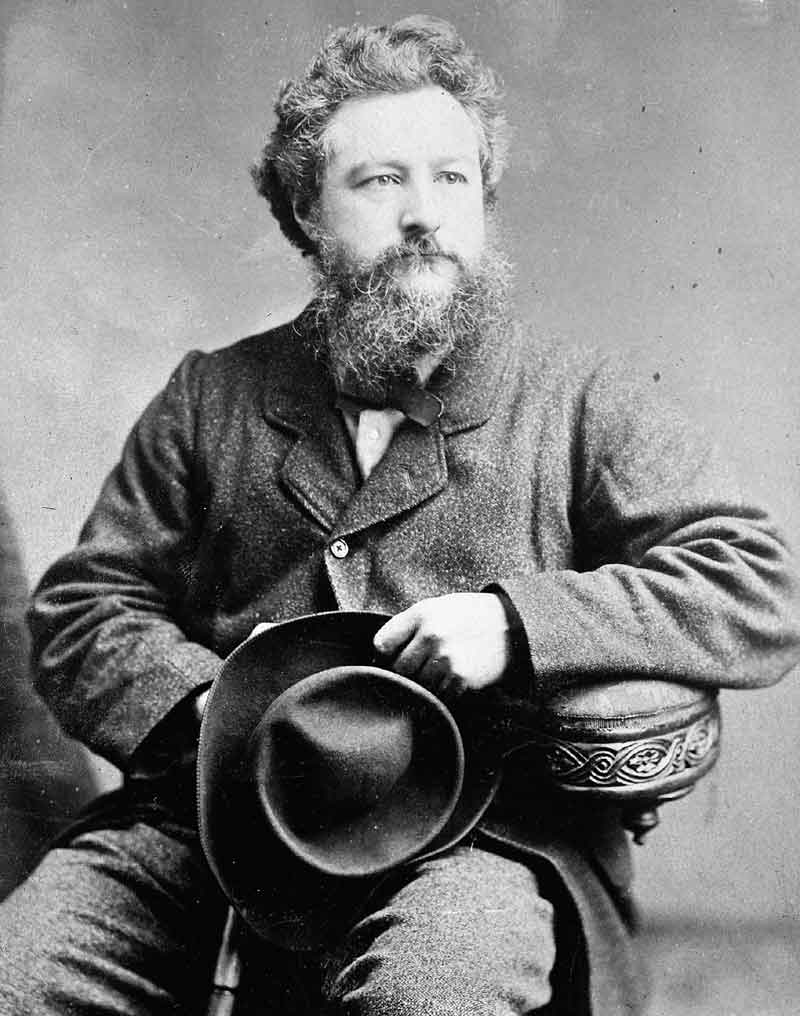‘If a chap can’t compose an epic poem while he’s weaving tapestry he had better shut up.’
Portrait of William Morris by Elliott and Fry, 1877
* * * * *
As well as being one of the most popular poets of his day, William Morris (24 March 1834-3 October 1896), was an outstanding designer and craftsman and a dedicated political thinker. He was born in Walthamstow and educated at Marlborough and Oxford. At Oxford he met his life-long friend Edward Burne-Jones and in 1856 the two young men moved to London and became part of the circle of the Pre-Raphaelite painter and poet Dante Gabriel Rossetti.
In 1857 Rossetti was commissioned to supervise decorative work in the new Oxford Union building. He enlisted his friends for this task, and during this period Morris met his future wife, Jane Burden. Morris and Jane married in 1859 and although their initial happiness did not last they remained together until Morris’s death. When Jane became involved in a relationship with Rossetti, he and Morris took on the lease of a house at Kelmscott in Oxfordshire, providing a refuge for Jane and the two children, and a place where she and Rossetti could be together away from the public gaze.
Morris was a prolific writer of poetry, fiction and essays. He published six volumes of poetry: The Defence of Guenevere (1858); The Life and Death of Jason (1867); The Earthly Paradise (1868-70); Love is Enough (1873); Sigurd the Volsung (1876); and Poems by the Way (1891). The Earthly Paradise brought him almost immediate fame and popularity.
In the 1870s Morris turned to Northern, particularly Icelandic, sources to find renewed inspiration. He wrote less original poetry but found time to translate the Aeneid, the Odyssey and Beowulf. He was approached with an offer of the Poet Laureateship after the death of Tennyson in 1892, but declined. His novel, The Wood Between the Worlds, is considered to have heavily influenced C.S. Lewis’s Narnia series. J.R.R. Tolkien was inspired by Morris’s reconstructions of early Germanic life in The House of the Wulfings, and James Joyce also drew inspiration from Morris’s work.
When he was dying one of his physicians diagnosed his disease as ‘simply being William Morris and having done the work of ten men’. In his obituaries he was remembered primarily as a writer and was compared favourably with Tennyson and Browning. Morris was generally reticent on the question of his religious beliefs but there is abundant evidence that he thought of himself as an atheist and regarded Christianity as a beautiful mythology. He is buried in St George’s churchyard at Kelmscott, with a gravestone designed for him by his friend, Philip Webb.
Ah, what begetteth all this storm of bliss
but Death himself, who crying solemnly,
E’en from the heart of sweet Forgetfulness,
Bids us “Rejoice, lest pleasureless ye die.
Within a little time must ye go by.
Stretch forth your open hands, and while ye live
Take all the gifts that Death and Life may give.”
Excerpt from ‘March’, published in William Morris: Selected Poems, Carcanet Press, 2002. This poem first appeared in Morris’s collection The Earthly Paradise, 1868-1870.
Text © Angela Williams 2009
NOTES, LINKS AND FURTHER READING
J. Bruce Glasier in William Morris and the Early Days of the Socialist Movement, London Longmans, 1921, quotes Morris on atheism: ‘…so far as I can discover from logical thinking, I am what is bluntly called an Atheist. I cannot see any real evidence of the existence of God or of immortality in the facts of the world…’ (p171).
Helen A. Timo, in An Icelandic Tale Re-told: William Morris’s ‘The Sundering Flood’ (Morris Society) states that ‘…Morris was generally reticent on the question of his religious beliefs, but there is abundant evidence that the words attributed to him by Glasier do broadly represent his personal convictions on the subject…’ (Follow this link to read the complete article as a PDF on the William Morris Society publications pages)
– The William Morris Society Home Page
MacCarthy, Fiona, William Morris: A Life for Our Time. Faber and Faber, 2003
Hero, Stephen, ‘Morris and James Joyce,’ The Journal of William Morris Studies. Summer 1985.
